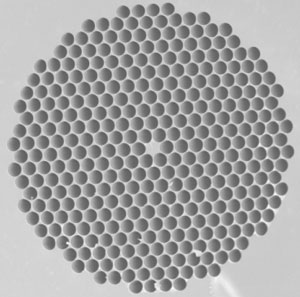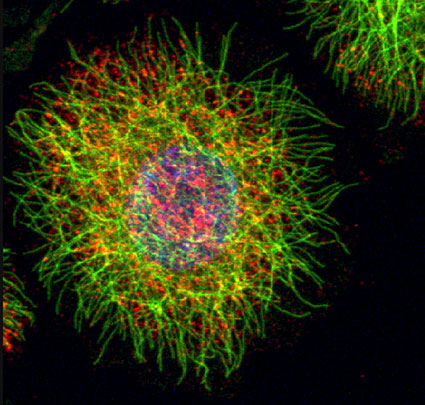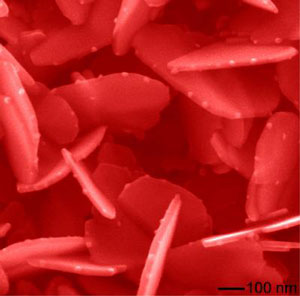Georgia Tech researchers are prominently represented among the authors in the newly released Encyclopedia of Nanoscience and Society, published by SAGE Publications, Inc.
Oct 19th, 2010
Read more
Wissenschaftlern der Universitaet Aarhus ist es zusammen mit Mikrobiologen der Justus-Liebig-Universitaet Giessen gelungen, Palladium-Nanopartikel mit biologischer Unterstuetzung herzustellen.
Oct 19th, 2010
Read more
 The Universidad Politecnica de Madrid's Artificial Intelligence Group has created a new DNA-based biological sensor that has potential applications in the field of genetic diagnostics. The basic sensor design was presented at the 2010 Conference on Unconventional Computation.
The Universidad Politecnica de Madrid's Artificial Intelligence Group has created a new DNA-based biological sensor that has potential applications in the field of genetic diagnostics. The basic sensor design was presented at the 2010 Conference on Unconventional Computation.
Oct 19th, 2010
Read more
 Photonic crystals could usher in an age of low-power optical computing, but they're hard to manufacture. Maybe adding a little DNA would help.
Photonic crystals could usher in an age of low-power optical computing, but they're hard to manufacture. Maybe adding a little DNA would help.
Oct 19th, 2010
Read more
 Precise regulation of tissue architecture is critical for organ function. Single cells build up a tissue by communicating with their environment and with other cells, thereby receiving instructions on whether to divide, change shape or migrate. An interdisciplinary group of researchers from several Max Planck Institutes have now identified a mechanism by which skin cells organize their interior architecture as a response to signals from their surroundings.
Precise regulation of tissue architecture is critical for organ function. Single cells build up a tissue by communicating with their environment and with other cells, thereby receiving instructions on whether to divide, change shape or migrate. An interdisciplinary group of researchers from several Max Planck Institutes have now identified a mechanism by which skin cells organize their interior architecture as a response to signals from their surroundings.
Oct 19th, 2010
Read more
Forscher machen Bewegung magnetischer Monopole in einer Anordnung von Nanomagneten sichtbar.
Oct 19th, 2010
Read more
Different conducting polymers form a special class of materials with the potential for many applications in organic electronics and functional materials. These polymers can be electronically conducting or semiconducting due to a conjugated polymer backbone, or alternatively possess conductivity due to mobile protons or other ions. A new thesis discusses such conducting polymers and shows ways how they can be processed by printing and how the nanostructure allows controlling their electrical properties.
Oct 19th, 2010
Read more
 For the first time scientists have been able to watch nanoparticles grow from the earliest stages of their formation.
For the first time scientists have been able to watch nanoparticles grow from the earliest stages of their formation.
Oct 18th, 2010
Read more
Theoretical work done at the Department of Energy's Oak Ridge National Laboratory has provided a key to understanding an unexpected magnetism between two dissimilar materials.
Oct 18th, 2010
Read more
Researchers at the UC Riverside Bourns College of Engineering have built and successfully tested an amplifier made from graphene that could lead to more efficient circuits in electronic chips, such as those used in Bluetooth headsets and toll collection devices in cars.
Oct 18th, 2010
Read more
Im Rahmen einer Kooperation mit Chemikern der Montanuniversitaet Leoben und Materialwissenschaftlern von Joanneum Research entwickelten Physiker und Chemiker der TU Graz ein photochemisches Verfahren, das es erlaubt, durch unterschiedliche Belichtungszeiten Schaltungen zu steuern.
Oct 18th, 2010
Read more
Susan Hockfield, president of the Massachusetts Institute of Technology, and Paolo Scaroni, CEO of the Italian energy company Eni, met today at MIT to review the progress of the Eni-MIT Alliance, an ambitious five-year research program.
Oct 18th, 2010
Read more
Researchers from Rice University's Laboratory for Nanophotonics (LANP), the radiology department at Baylor College of Medicine (BCM) and the University of Texas MD Anderson Cancer Center are preparing to test a combined approach for diagnosing and treating pancreatic cancer with a specially engineered nanoparticle.
Oct 18th, 2010
Read more
 New York University has received a $1.6 million National Science Foundation grant to upgrade its Structural DNA Nanotechnology facility. Structural DNA nanotechnology uses synthetic DNA molecules to create new materials.
New York University has received a $1.6 million National Science Foundation grant to upgrade its Structural DNA Nanotechnology facility. Structural DNA nanotechnology uses synthetic DNA molecules to create new materials.
Oct 18th, 2010
Read more
Vor genau zwei Jahre praesentierte das AIT Austrian Institute of Technology am 20. Oktober 2008 weltweit zum ersten Mal ein quantenkryptographisches Netzwerk, resultierend aus einer Kooperation mit den fuehrenden europaeischen Gruppen, darunter auch der Uni Wien. In den Tagen zwischen 18. und 20.Oktober 2010 erfolgt eine neuerliche Live-Praesentation.
Oct 18th, 2010
Read more
Scientists have captured the first direct images of magnetic monopoles which were theoretically conceived by the British-Swiss physicist Dirac in the early 1930s who showed that their existence is consistent with the ultimate theory of matter - quantum theory.
Oct 17th, 2010
Read more






 Subscribe to our Nanotechnology News feed
Subscribe to our Nanotechnology News feed